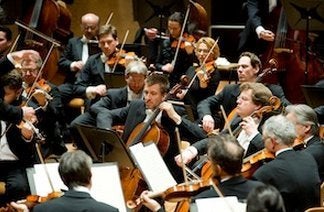
I first wrote an analysis of the Berlin Philharmonic a couple of years ago. It was widely read but seemed to create some confusion. Was I making a direct comparison between a European orchestra that enjoys substantial amounts of government subsidy and American orchestras which receive virtually none? Actually I was. But the comparison wasn't based upon where resources came from, but how resources were being used.
When I first started to examine the Berliners, I expected to find something very conservative and traditional. I could not have been more wrong. Instead, I found an organization positioning itself as an important, relevant, legitimate and powerful contemporary force for music, the community and society. The total re-examination of leadership including the role of the Chief Conductor, the empowerment of the musicians, their efforts to alleviate societal problems and their innovation and creativity, were quite frankly a revelation.
So at a time when many people are suggesting a re-examination of the American orchestra model given its apparently intractable problems and dynamics, here is an opportunity to look at musical life differently. After all, it doesn't matter where resources come from -- U.S. tax credits, endowments, vs. European government subsidy -- what is important is how resources are used to develop an organization into something of contemporary vibrancy.

When the Berlin Philharmonic was created in 1882, its 52 musicians decided to do business differently. They wanted a democratic system that not only involved the musicians, but empowered them as well. So they came up with a musical mission informed by a strong entrepreneurial spirit. Interestingly, when the London Symphony was established in 1904, they used the Berlin Philharmonic as their model.
Public Foundation Offers Independence
Now 131 years later and boasting 128 members, the Orchestra today is still driven by these fundamental principles. It is currently organized as a Public Foundation, a structure that I have never previously encountered and which is relatively new to the Orchestra. Prior to 2001, the musicians of the Berlin Phil were employees of the City of Berlin, being paid at taxpayers' expense along with civil servants and teachers. As a Public Foundation, the orchestra has become more independent and also more responsible for its own budget, The City of Berlin provides a subsidy to the Foundation of €14.4 million ($18.72 million) for the running of the Philharmonie (the home of the orchestra) with its two concert halls and about 500 events per year and the actual operation of the orchestra itself. The overall annual budget is € 41.4 million ($53.82 million). The current refinancing rate is therefore approximately 63 percent.
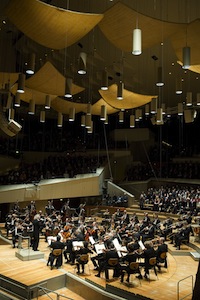 Photo Credit: Monika Rittershaus
Photo Credit: Monika Rittershaus
The Board of Trustees of the Foundation numbers 10 and includes three politicians from the Senate (the Minister of Culture is the ex-officio President and two others are elected by Parliament), members of the Orchestra, members of the Friends of the Orchestra, and the chair of the Orchestra Academy (I will talk about the Academy in detail shortly). Reporting to the Trustees is a Joint Executive Committee of four, comprising the Chief Conductor, the General Manager (Intendant) and two musicians who are both Chairs of the Orchestra. It is this smaller group that sets the strategic and artistic direction of the Orchestra, chooses the programs, and settles any issues. The Orchestra also has an advisory Orchestral Committee Council of five which is used as a sounding board for the two musician Chairs. In addition there is a seven-strong Employees' Council, with no artistic role, but which is responsible for contractual and personnel matters for all, including non-musician staff members. So, it is the musicians who manage themselves, from scheduling concerts, to making tour arrangements, or handling delicate personnel matters. There is not only the Board of Trustees but also the Orchestra membership in their full session meetings to which the Executive must answer. The full Orchestra Plenum is the other "highest court."
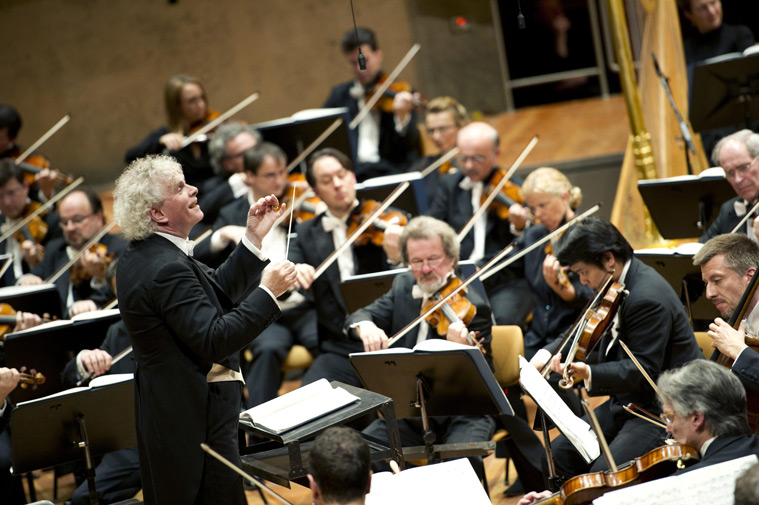 Photo Credit: Monika Rittershaus
Photo Credit: Monika Rittershaus
The Chief Conductor, currently Sir Simon Rattle, is Artistic Director and a member of the executive management committee and is responsible for his own programmes. He also exerts some influence over the programmes of guest conductors, but these are always discussed by the executive committee. The Artistic Director exerts very little influence over hiring and none over firing. In fact, the audition process is totally inclusive. Every member of the orchestra takes part forming an audience for the auditioning candidates on the stage of the Philharmonie. There are 128 votes and the Artistic Director, like everyone else, has just one. The audition tests stylistic understanding and qualities of sound and expression. Technique is a given but never used as the main criterion. I was told by one player that he and his colleagues were looking "to have their souls touched by the music-making."
At Home in Spectacular Hall
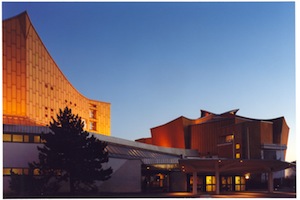 Photo Credit: Schirmer
Photo Credit: Schirmer
The Orchestra gives about 100 concerts at the Philharmonie, one of the world's great concert halls. Designed by Hans Scharoun and built in the early 1960s (the Orchestra was without a home after 1945 and played everywhere from cinemas to church halls), the hall is a gem and provides a wonderful intimacy through overlapping terraces that reduce the distance from the stage to the listener. The style of the concert hall has been the inspiration for many new auditoriums since that time, from Saint David's Hall, Cardiff, to the Royal Concert in Nottingham in the U.K.
The Philharmonie has a capacity of over 2,400 seats and the BPO enjoys average attendance of 98 percent. Audience are diverse, ranging from core subscribers aged 50-plus to a young audience 20 to 30 years old who descend upon the Orchestra for unusual contemporary programs.
The Musicians' Life
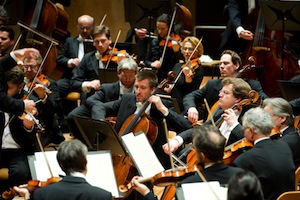
Photo Credit: Monika Rittershaus
In addition to the 100-concert Philharmonie series, the Orchestra gives a further 30 concerts on tour, including opera work. A regular week includes up to four approximately 2½ hour-long rehearsals (with no clock on stage), a dress and then three to four concerts. There are no restrictions on the length of a concert, length of tours, number of acoustical rehearsals when on tour, etc.
Base salary is €90,000 gross ($117,000) for all rank and file players. Principals receive 15 percent extra. There is no individual negotiation of personal contracts as happens in the USA. Transparency and equity are seen as essential to solidarity and the stake-holder attitude of all members.
The musicians are legally entitled to six weeks paid vacation in the summer, but through careful season planning can generate an additional seventh week. Similarly, they have generally been able to organize an additional week of paid vacation in early January.
Healthcare in Germany is extensive and excellent; all employed individuals are required to buy either public or private insurance and employers contribute up to 50 percent of the premiums. Most medical services are delivered by state-funded institutions and individuals can pay for additional private coverage at their own cost.
There is a national mandatory retirement age of 67 to which the Orchestra must adhere. This was described to me as "equal injustice for all" and it has the effect of circumventing the sensitive problems of aging musicians. The State provides an index-linked pension programme which is supplemented through a compulsory Union-organized plan. Contributions to both plans are made 50-50 by musicians and the employer.
Like all German orchestras there is no endowment, and the budget is balanced through subsidy from the City, box office receipts and touring fees. Financially, the Orchestra is doing very well and is deficit free (currently the subsidy is less than 40 percent of the overall budget). I learned that the German political Constitution mandates support of the arts.
Musicians Seek Range of Styles, Experiences
All guest artists who perform with the Orchestra are there at the invitation of the musicians, including the Chief Conductor and all the guest conductors. The players deliberately choose guests who present interesting artistic and stylistic opportunities, including the chance to explore historic performance practice. So for example, the Berliners work regularly with Sir John Eliot Gardiner, Nikolaus Harnoncourt, Philippe Herreweghe and William Christie.
The Philharmonic's repertoire is eclectic, to say the least, and includes Vivaldi and Bach, as well as Ligeti, Schoenberg and Harrison Birtwistle. For early music, many players perform on gut strings with baroque bows, and wind players use wooden flutes. Whilst the Philharmonic hasn't become a specialist period instrument band, the musicians are nevertheless pushing their own boundaries artistically.
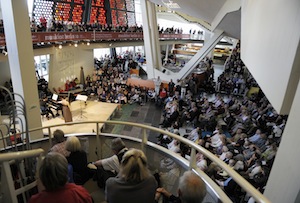 Photo Credit: Stefanie Loos
Photo Credit: Stefanie Loos
Besides playing in the Orchestra, every musician is expected to be a soloist, perform chamber music and contribute to the overall vision of the Orchestra. Looking at the website, I counted some 30 recognized ensembles including the Berlin Philharmonic Wind Quintet, Amarcord-Quartet, Philharmonic Piano Quartet, and Berlin Baroque Soloists. I was told there are at least another six not cited. These ensembles, many of which we see on the international touring circuit, are organized and managed by the musicians, working as entrepreneurs from within the orchestra. These groups are also presented at the smaller chamber music hall at the Philharmonie. The musicians prepare their programmes in their own time and at their own expense. They will only receive additional compensation for the series at the Philharmonie. The qualities of chamber music are seen as being at the centre of their work as an Orchestra allowing them artistic collaborations that inform the character of the full orchestra.
Embedded in the Community
But it isn't just classical music that is promoted. The Berliners' educational portfolio also includes jazz, ethnic and contemporary music, improvisation and dance. One of the biggest undertakings each year for 10 years has been a Dance Project for teenagers at risk through which youngsters are galvanized into a performance of, say, Rodion Shchedrin's Carmen Suite with the BPO and Rattle in a downtown location. Now they have begun a children's chorus project, also aimed at youth at risk.
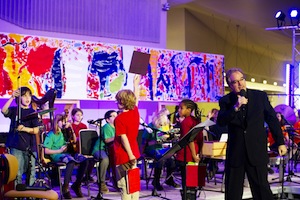 Photo Credit: Berlin Philharmonic
Photo Credit: Berlin Philharmonic
Because music education is becoming less and less important in the schools, the players are also trying to fill in those gaps. Their education projects relate back to the main orchestra with the idea that kids should see and hear the Orchestra at its home. So, if the Orchestra has on its series Debussy's La Mer, the players will devise interactive projects based on the idea of the sea. Composition plays an important part of in this educational work and performances of student pieces involving BPO musicians are a regular feature.
The musicians' work touches many, from kindergarteners to prisoners, from teachers to lifelong learners. There is no contractual obligation for the musicians to do this work. They are paid no additional fees -- just travel expenses. They do it because they understand the inherent transformative power of music and want to share that with audiences who have not previously experienced it. This educational work is generously funded by the orchestra's sponsor Deutsche Bank; it does not come out of the general budget.
The Digital Concert Hall
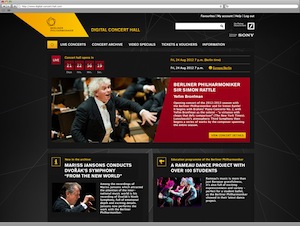 Photo Credit: Berlin Phil Media
Photo Credit: Berlin Phil Media
The Orchestra is increasingly exploring the potential of technology and one of its great innovations is the "Digital Concert Hall," a subscription series of streaming concerts displaying the highest production values (better than CD sound plus High Definition picture). Live streaming has become very popular and for every sold out house of 2,400 concert-goers, there are the same number watching at home.
Little net income is generated for Orchestra members, soloists and conductors by these digital events. Instead they believe this is a necessary new activity and see their participation as a "stakeholder's responsibility." The series has introduced the Orchestra to a whole new global audience. This new project is now seen as a huge force in promoting and reinforcing the brand of the Orchestra. Again, the idea for this project came from a musician who saw it through from concept to delivery. The two orchestra Chairs work with the Committee Council in considering new media projects, and the Orchestra is very active in recording, T.V., and other broadcasting.
Given the Orchestra's technical savvy, it's probably no surprise that it is also involved with social media, getting its name and activities broadcast through that viral network. So, for example, it can boast 341,352 Likes or fans who follow the Orchestra on Facebook. The London Symphony has 54,369. The Los Angeles Philharmonic has 50,369 followers, The Detroit Symphony has 14,683, and the Boston Symphony Orchestra 25,563 fans.
The Orchestra Academy
 Photo Credit: Tim Deussen
Photo Credit: Tim Deussen
The Orchestra Academy created in 1972 by Herbert von Karajan provides training opportunities for outstanding young musicians aspiring to an orchestral career.
The impetus for this programme was the recognition that traditional conservatory training was not providing the level of preparedness that young musicians need, particularly if they aspired to play in the Berlin Philharmonic. Designed for up to 30 young artists, the program offers a two-year, post-graduate course that includes coaching by members of the orchestra, chamber music experience, and performance with the BPO in three programmes within a two-month period. The Academy students receive a stipend of €950 ($1,387), as well as all tuition. Many of the alumni go on to become members of the BPO; in the current roster about 20 percent of the musicians came through the Academy. What's more, many of the other top orchestras in Germany and Europe boast large numbers of Academy alumni.
The World's Premiere Orchestra
The last time I saw the Berlin Phil was at Carnegie Hall last year when they gave the first performance of the "reconstructed" Bruckner Ninth Symphony.
I thought it was the greatest orchestra I had ever heard. I thought that the time before, too. The performances have such energy, such commitment, such movement, indeed the musicians move physically with the music. Even their very presence on stage speaks of a different level of communication and engagement. I was very much taken by their tradition at the end of the concert of shaking hands and thanking their colleagues.
As an ensemble, the Berliners have demonstrated an impressive ability to reinvent and rejuvenate, doing things differently from self-governance to historically informed performance practice to community engagement and social responsibility. Their model is not the vision of any one leader. It comes instead from a collective of musicians who are empowered to be creative with new ideas, new directions, and new challenges. Whether it's a project like the "Digital Concert Hall" or their work in prisons, it all emanates from the desire of the musicians to interact with the contemporary world differently than they did in the past. Because it is ultimately responsible for its own fate -- the orchestra has always cultivated a culture of stake-holding and strategic thinking -- otherwise on any number of occasions throughout its 130-year history, the ensemble wouldn't have survived. It has always been up to the musicians to manage themselves, particularly in moments of crisis. The Berliners' model should lead us all to imagine more flexible and responsible organizations that have music as their mission, and the community as their foundation.
Is this the "Coolest Band in the World?" Yup... I think so.